

8 Reasons Why Site Visits Are The Best Learning Experience

Whether you are just starting out in the field of architecture or an architect with 40 years of experience, site visits play a central role to our professional development. Most of the times, site visits take place during the construction phase of a project. It is during this stage where a team of multidisciplinary professionals physically get together to realize things previously drawn on paper in real, three-dimensional space. This long and complex process inevitably presents a series of challenges, but precisely so, it offers unique learning opportunities for architects , designers , and everyone else involved. From gaining professional knowledge to developing important life skills, here are eight reasons why site visits are the best learning experience:

1. Site visits allow for an authentic and accurate experience of the space.
While we may think we know a space or building inside out from all the overtime put into drawing plans, elevations, and sections, not to mention creating photorealistic renderings, site visits might prove that the actual space turns out looking and feeling a lot different from what we had envisioned. Physical factors such as time of day, temperature, and human traffic all affect our perception of a space or building, but the effects of these can never be conveyed sufficiently through mere two-dimensional drawings and it is by being on-site that we experience these factors at work and get an accurate understanding of the space.
2. Sometimes, site visits before the design phase of a project is crucial in helping us understand the local culture of a place.
When a project is located in a place unfamiliar to us, a site visit not only allows us to conduct site analysis, but also exposes us to the local way of life and the unique culture of the place. No amount of research in the office can beat being on-site and being physically and psychologically immersed within the environment. This is important so that we can create design solutions that are sensitive and responsive to the particular needs and characteristics of a place.
3. We learn most of the specifics of construction and construction methods on-site.
It is widely agreed among professionals that architectural education in schools rarely does a good job of exposing students to methods of construction. Schools are focused on teaching students to think conceptually and to sell their architectural designs, but when it comes to actual materials and construction, being on-site lets us witness how different materials and components come together and the processes and mechanisms involved in building. In fact, ask any professional in the field and they are likely to tell you that most of their knowledge of construction came from years of on-site experience.
4. Site visits allow us to learn from the expertise of other professionals.
Most of the times, site visits mean meeting professionals of other fields. Through our discussion of problems and solutions with professionals such as engineers, contractors, and electricians, we not only gain knowledge of other disciplines that will be helpful to our work, but more importantly see their expertise being applied in real life on the job site. Understanding aspects of a design from their perspective also helps us foresee and prevent potential problems in our design proposals.
5. Site visits expose us to concerns of safety.
Probably one of the first images that comes to mind when we speak of a construction site is that of people wearing helmets, and this shows just how important safety is on-site. When drawing or specifying a curtain wall glass panel on the computer, we do not have to personally deal with the physicality and weight of this massive material. At a site visit, however, the physical presence of large and heavy materials poses an immediate threat to our safety. An awareness of on-site safety is crucial to a smooth and successful construction process.
6. Site visits train us to think and make decisions on our feet.
When a project runs into a problem at the construction site, architects and designers often need to have discussions with other professionals to arrive at a decision on the spot. From a substitution of materials to signing an agreement, these things force us to be alert to various factors and consequences under a tight time constraint. Many of these decisions have major impacts on a project timeline and cost, so it is important to have the critical awareness and thinking skills needed to make such decisions when they are required of us.
7. Discussions and negotiations during site visits build our interpersonal and communication skills.
As different disciplines often have different methods of working, discussions and negotiations with a multidisciplinary team on-site require us to have good communication skills so that we can effectively convey our thoughts and relate to everyone involved. These conversations allow us to build interpersonal skills and learn from the various communication and working strategies of other professionals so that we become better at collaboration, management, and leadership.
8. When things do not go as planned, site visits let us understand why and how a design failed.
Sometimes, what we draw as two-dimensional plans, elevations, sections, and construction details fail to translate successfully into three-dimensional realities. It is useful to see the physical space or materials and talk with other professionals on-site to understand exactly how and why a design did not turn out the way we envisioned. Such experiences will give us the necessary foresight to prevent similar mistakes in the future projects.
Ultimately, site visits not only allow us to gain more technical and practical knowledge about materials and construction processes, but also offer opportunities to build valuable life skills that we can apply in our daily lives. Nonetheless, all these learning opportunities are only as much as we make of them. By paying more attention to the processes and complexities at a site visit, we might make our experience much more interesting and meaningful than it appears to be.

Lisa graduated in 2018 with a Bachelor’s degree in interior design and a few internship experiences. She is currently completing her Master’s degree in art history and studying architectural renderings for her thesis. Her passion is thinking critically about everything architecture: from architectural movements to contemporary professional practices.

Yi’s House Showroom By Peng & Partners

FAB Cinema By X+LIVING
Related posts.

Archi-Urbantecture

A Green Future in Architecture: Sustainable Design Reconfiguration

Erasing Heritage: How Minimalist Design Neutralizes Urban Identity

A Call to Action: Rethinking the Built Environment for a Changing Climate

The Impact of Globalization on Cultural aspects

Client Collaboration in Storytelling Architecture
- Architectural Community
- Architectural Facts
- RTF Architectural Reviews
- Architectural styles
- City and Architecture
- Fun & Architecture
- History of Architecture
- Design Studio Portfolios
- Designing for typologies
- RTF Design Inspiration
- Architecture News
- Career Advice
- Case Studies
- Construction & Materials
- Covid and Architecture
- Interior Design
- Know Your Architects
- Landscape Architecture
- Materials & Construction
- Product Design
- RTF Fresh Perspectives
- Sustainable Architecture
- Top Architects
- Travel and Architecture
- Rethinking The Future Awards 2022
- RTF Awards 2021 | Results
- GADA 2021 | Results
- RTF Awards 2020 | Results
- ACD Awards 2020 | Results
- GADA 2019 | Results
- ACD Awards 2018 | Results
- GADA 2018 | Results
- RTF Awards 2017 | Results
- RTF Sustainability Awards 2017 | Results
- RTF Sustainability Awards 2016 | Results
- RTF Sustainability Awards 2015 | Results
- RTF Awards 2014 | Results
- RTF Architectural Visualization Competition 2020 – Results
- Architectural Photography Competition 2020 – Results
- Designer’s Days of Quarantine Contest – Results
- Urban Sketching Competition May 2020 – Results
- RTF Essay Writing Competition April 2020 – Results
- Architectural Photography Competition 2019 – Finalists
- The Ultimate Thesis Guide
- Introduction to Landscape Architecture
- Perfect Guide to Architecting Your Career
- How to Design Architecture Portfolio
- How to Design Streets
- Introduction to Urban Design
- Introduction to Product Design
- Complete Guide to Dissertation Writing
- Introduction to Skyscraper Design
- Educational
- Hospitality
- Institutional
- Office Buildings
- Public Building
- Residential
- Sports & Recreation
- Temporary Structure
- Commercial Interior Design
- Corporate Interior Design
- Healthcare Interior Design
- Hospitality Interior Design
- Residential Interior Design
- Sustainability
- Transportation
- Urban Design
- Host your Course with RTF
- Architectural Writing Training Programme | WFH
- Editorial Internship | In-office
- Graphic Design Internship
- Research Internship | WFH
- Research Internship | New Delhi
- RTF | About RTF
- Submit Your Story

Free Site Analysis Checklist
Every design project begins with site analysis … start it with confidence for free!
Site Visit Analysis and Report: How to conduct and evaluate your first architecture site visit
- Updated: January 2, 2024
Here we will cover everything you need to know about of how to approach your first site visit analysis for a new project, what to do when physically there, and how to eventuate and summarize the information you collect.
However before visiting for the first time we highly recommend that you carry out desktop study beforehand, as this will provide an important initial understanding of the site and generate far better results and more refined questions once there.
The desktop study will also help to identify the important items of equipment that you will need to take with you to make your trip as successful as possible. …these are mentioned below but may include a:
- Site map (very important)
- Tape measure
- Laser distance meter
…more essential architects items here

Conducting an architecture site visit analysis
A site visit analysis is a comprehensive report that summarizes the findings of a physical inspection of a potential development site. It includes information on the site’s physical characteristics, location, surrounding area, demographic information, environmental impact, zoning regulations, traffic flow, and recommendations for development.
The report synthesizes all gathered information to provide a comprehensive understanding of the site and its potential.
What to look for?
Once there, there are a whole number of important areas and items that need to be studied and recorded, some of which would have already been identified during your desktop study, but as a starting point we’ve produced the below list of all the key areas:
We suggest that you take these with you and tick them off as they are found, so not to miss anything.
- Entrance and access points (both pedestrian and vehicle)
- Security (gates, surveillance)
- Travelling to the site (road types and suitability, safety, public transport)
- Boundary treatment (fencing, vegetation, land form, water)
- Extent of boundary (does it match the survey/OS map)
- Circulation (existing travel routes within the site)
- Noise levels (quiet and loud areas)
- Services (electric, gas, water, sewage)
- Existing buildings (condition? Relevant? Protected?)
- Existing landscape features (condition? Relevant? Protected?)
- Neighbouring buildings (local vernacular, protected?)
- Views in and out of the site (areas to screen off and areas to draw attention to)
- Tree’s and vegetation (protected and rare species)
- Ecology (any areas likely to be home to protected species)
- Orientation (sun and wind paths)
- Light levels (areas in direct sunlight, shaded areas, dappled light)
- Accessibility (disability access)
- Surrounding context (historical, heritage, conservation area, SSSI, AONB)
- Existing materials in and around the site
- Topography (site levels)
- Flood level (is it likely to flood)
- Soil and ground conditions (types and suitability)
- Existing legal agreements (where are the rights of way, covenants)
- Hazards (Electricity lines, Drainage, Telephone lines, Sub-stations)
We provide a site analysis checklist here covering all of the above that’s free to download.

Where to start
You want to begin documenting your visit as soon as you arrive, as the approach and entrance to your site are just as important as the site itself. If you’re desktop study didn’t highlight the possible routes and methods of transport to and from the site, then this needs to be recorded also.
Documenting your first impressions is vitally important, ask yourself; what do you see as you enter the site? what do you hear? what do you feel? (…what senses are the first to be triggered), you will only get one chance to do this properly and so you need to make it count!
…and don’t forget to include the location of the elements you record, when noting it down on your site map or survey. By the end of your visit, you should barley be able to read whats under all your notes …write down everything!
Moving on from first impressions, you should plan to walk around the site as least twice (as a minimum) to ensure that nothing is missed, so leave enough time to make a least two loops, noting down and photographing everything that you feel is relevant, no matter how small.
…there’s nothing worse than getting back to the studio and realizing you forgot to document something.
We like to use the check list supplied above and:
- Firstly walk around the site whilst annotating a site plan
- Secondly with a camera …photographing everything
- and thirdly with both …just in case something has been missed
This way we can focus on one task at a time, helping to ensure we gather everything we need.
In terms of a camera, and depending on your budget we suggest looking one these three options (but a phone is just as good):
- Sony DSCW800 Digital Compact Camera
- Sony DSCWX350 Digital Compact Camera
- Canon EOS 1300D DSLR Camera
It can be difficult to identify certain elements, and some may only be noticeable from a professional survey, such as underground services and precise spot levels. But approximations of such locations and heights are a good start and can serve as a reminder for further investigation.
If accessible you can of course take your own measurements and so this is where a tape measure and/or distance meter will come in handy.
Try one of these:
– Tape measure
– Laser distance meter
What to take with you
Firstly look at the weather, you wont have a good time if your not dressed appropriately, and this applies to protecting your notes and equipment as well as yourself.
…a simple quick check, can make or break a visit, arranging to go on sunny day will also give you the best site photographs, which could also be used in future CGI’s and presentation material.
If the site is derelict, or has potentially dangerous or hazardous elements, it is likely that you will require personal protection equipment (otherwise known as PPE) so make sure this is organised before setting off.
As a minimum you want to take with you a camera, a pen and an OS map. Google Maps can provide a temporary (though very basic) version, but a much preferred scaled version that can normally be obtained through your university or practice via such companies as:
- Digimap – digimap.edina.ac.uk
- Xero CAD – xerocad.co.uk
- CAD Mapper – cadm a pper.com (free account available)
As mentioned, you will want to make notes, and record everything you observe, experience and hear all over this map. So print out a couple of copies at a usable and convenient size.

A camera is essential in documenting the site, and the pictures taken during your visit are likely to be used on a daily basis throughout your project. So once again make sure you document and record everything.
Pictures should be taken from all distances, close zoomed-in sections of materials and textures along with shots of the site from a distance to include the area as a whole and within its context.
Note pads are important for obvious reasons, we prefer an A5 sized pad, as this is much easier to carry and hold than an A4 one.
Tape measures can be useful, but we never go on a site visit without a distance meter.
…and lastly if you’re visiting on your own, don’t forget to tell someone where you’ll be and take your phone with a charged battery.
Our site visit equipment check list looks something like this:
- Weather check
- Print out our “what to look for” checklist
- Site map (at least 2 copies)
- PPE equipment
- Scale ruler
If you are interested in trying our architecture site analysis symbols for your own site analysis recordings and presentation, then head over to our shop ( Here ).
FAQ’s about site visit analysis
What is included in a site analysis.
As discussed above, site analysis typically includes the following elements:
- Site location and context: Understanding the location of the site in relation to the surrounding area, including climate, topography, neighboring buildings, and accessibility.
- Physical characteristics: Examining the site’s physical features, such as its size, shape, soil type, vegetation, and water sources.
- Utilities and infrastructure: Assessing the availability of utilities such as electricity, water, gas, and sewer, as well as the infrastructure, such as roads and transportation.
- Environmental considerations: Analyzing the site’s potential environmental impact and assessing any potential hazards, such as flooding or soil stability.
- Zoning and land-use regulations: Reviewing the local zoning and land-use regulations to determine the types of uses and development allowed on the site.
- Cultural and historical context: Examining the cultural and historical significance of the site and its surrounding area.
- Demographic information: Analyzing the demographic information of the surrounding area, including population, income, and age.
- Traffic and pedestrian flow: Studying the flow of vehicular and pedestrian traffic in the area to understand the impact on the site.
This information is used to inform the design of a building or development project, taking into account the unique characteristics and constraints of the site.
What are the steps of site analysis?
including the above, the steps involved in conducting a site analysis report typically include:
- Data Collection: Gather data and information about the site, including maps, aerial photos, zoning regulations, environmental reports, and other relevant documents.
- Site Observations: Conduct a site visit to observe and document the site’s physical and environmental conditions, such as topography, vegetation, water sources, and neighboring buildings.
- Context Analysis: Analyze the site’s location and context, including its surrounding area, access to transportation, and cultural and historical significance.
- Demographic Analysis: Study the demographic information of the surrounding area, including population, income, and age, to understand the potential market for the development project.
- Traffic and Pedestrian Flow Analysis: Study the flow of vehicular and pedestrian traffic in the area to understand the impact on the site.
- Synthesis: Synthesize the information gathered in the previous steps to develop a comprehensive understanding of the site and its potential.
- Recommendations: Based on the analysis, make recommendations for the development of the site, taking into account the unique characteristics and constraints of the site.
These steps help architects and planners to gain a deeper understanding of the site and to make informed decisions about the design and development of a building or project.
Every design project begins with site analysis … start it with confidence for free!.

- Construction Details
Masonry Detail Kit
- £ 19.99
- Add to basket

Detail Template Kit
- £ 29.99

Timber Construction Detail Kit

Steel Frame Detail Kit
Leave a reply cancel reply.
You must be logged in to post a comment.
As seen on:

Unlock access to all our new and current products for life .
Providing a general introduction and overview into the subject, and life as a student and professional.
Study aid for both students and young architects, offering tutorials, tips, guides and resources.
Information and resources addressing the professional architectural environment and industry.
- Concept Design Skills
- Portfolio Creation
- Meet The Team
Where can we send the Checklist?
By entering your email address, you agree to receive emails from archisoup. We’ll respect your privacy, and you can unsubscribe anytime.

- Quality & Safety
Start typing and press Enter to search

(+55) 254. 254. 254
Helios Tower 75 Tam Trinh Hoang Mai - Ha Noi - Viet Nam

7 Reasons Why Site Visits Are The Best Learning Experience
Site visits are the best way to learn what a career in the construction industry is all about. Not only will you get to see first-hand what goes into the projects, but also what challenges and rewards come with working directly with your clients. You’ll get to meet other professionals who can help guide you and maybe even inspire some new ideas for your work!
Meet the professionals
However, the best part of a site visit is that you get to meet the professionals. They are there, working on what they do best, and it’s your job to talk with them and ask questions about their work. You can learn about how they got started in their field and what got them interested in it in the first place. You can even ask for advice on whether this particular profession is right for you!
Build intrapersonal and communication skills
A site visit will allow you to work in a team, learn to communicate with people, and develop your leadership skills. These are some of the most important skills needed for any job and you should get them early on in your career. A site visit provides an excellent learning experience, where you can build these skills while also meeting industry professionals and building a network of contacts who can assist you with future opportunities.
As well as developing interpersonal communication skills, a site visit will help you learn how to work under pressure. When on a live project, there is always something going on which requires your attention right away – no time for excuses! That’s why it’s so important that we teach people how to think quickly and make decisions under pressure for them to be successful when faced with similar situations later down the line in their careers (or life).
Transparency
Site visits are the best learning experience for a few reasons. You will know what to expect and when to expect it. You will also know what your client wants and expects from you, which is useful if you want to deliver a quality product in a reasonable amount of time. This transparency allows us to provide a better overall experience for our clients because they can trust that we are doing everything we can to meet their expectations.
Know what to expect
A site visit can be a fascinating thing. You are getting a chance to see how other companies do things and how these processes work. This is an opportunity for you to bring back new ideas that you can use in your workplace. The more information you have about what’s going on, the better prepared you will be for the task at hand.
There are many benefits from visiting another company, such as setting expectations, knowing what to expect, making plans, and preparing for the unexpected.
See other projects in progress
You can see what other projects in progress look like, and you may have the opportunity to talk with the contractor on-site. Seeing how another contractor works can teach you a lot about managing time and keeping your project on track, which is especially important when working with a client.
If you’re looking for more information about site visits for contractors and how they can benefit your business, visit our website at Soleil Building Contracting LLC.
Learn from a professional
Learn from a professional: A site visit is probably your first time in the field, and you may be nervous about what to expect. Your supervisor will walk you through everything, including how to conduct yourself and what to look for when inspecting the area. This is crucial because it not only teaches you how to do your job properly but also helps build confidence.
Gain experience and knowledge: The best way to learn is by doing—and who is better than an experienced professional mentor? As part of your training program, they can help teach you valuable lessons that will make all the difference between a successful career in construction or being left behind by younger workers who are quick learners than yourself.
Learn from mistakes: No one’s perfect! Everyone makes mistakes in life; but if we’re lucky enough (or unlucky enough) enough then someone else has done something similar at some point along their path too – so why not learn from them? Every mistake made has been made somewhere else, which means there’s no need to worry either as long as it hasn’t happened recently!
Exposure to safety concerns
Safety is a priority in the construction industry, and it should be. Safety concerns are important for site visits because you never know if you’re going to encounter dangerous situations or not. It is always better to be safe than sorry, so if you can learn about safety concerns at the site visit, then great!
The best way to learn is by doing, and site visits are the best way to learn from professionals. They allow you to see what they do in their day-to-day work, talk with them about their experiences and share yours, as well as ask questions that may arise during your visit. You’ll also be able to get feedback on your projects or potential client’s needs before signing anything! We hope these reasons have convinced you why site visits should be part of every designer’s education process.
If you are looking for the best civil contracting companies in the UAE , with expert planning and execution, then look no further than Soleil . Soleil has years of experience backing them in construction and maintenance. Avail the services from the best construction company in Dubai. Contact us today!
Leave a Reply Cancel reply
Save my name, email, and website in this browser for the next time I comment.
Related Post
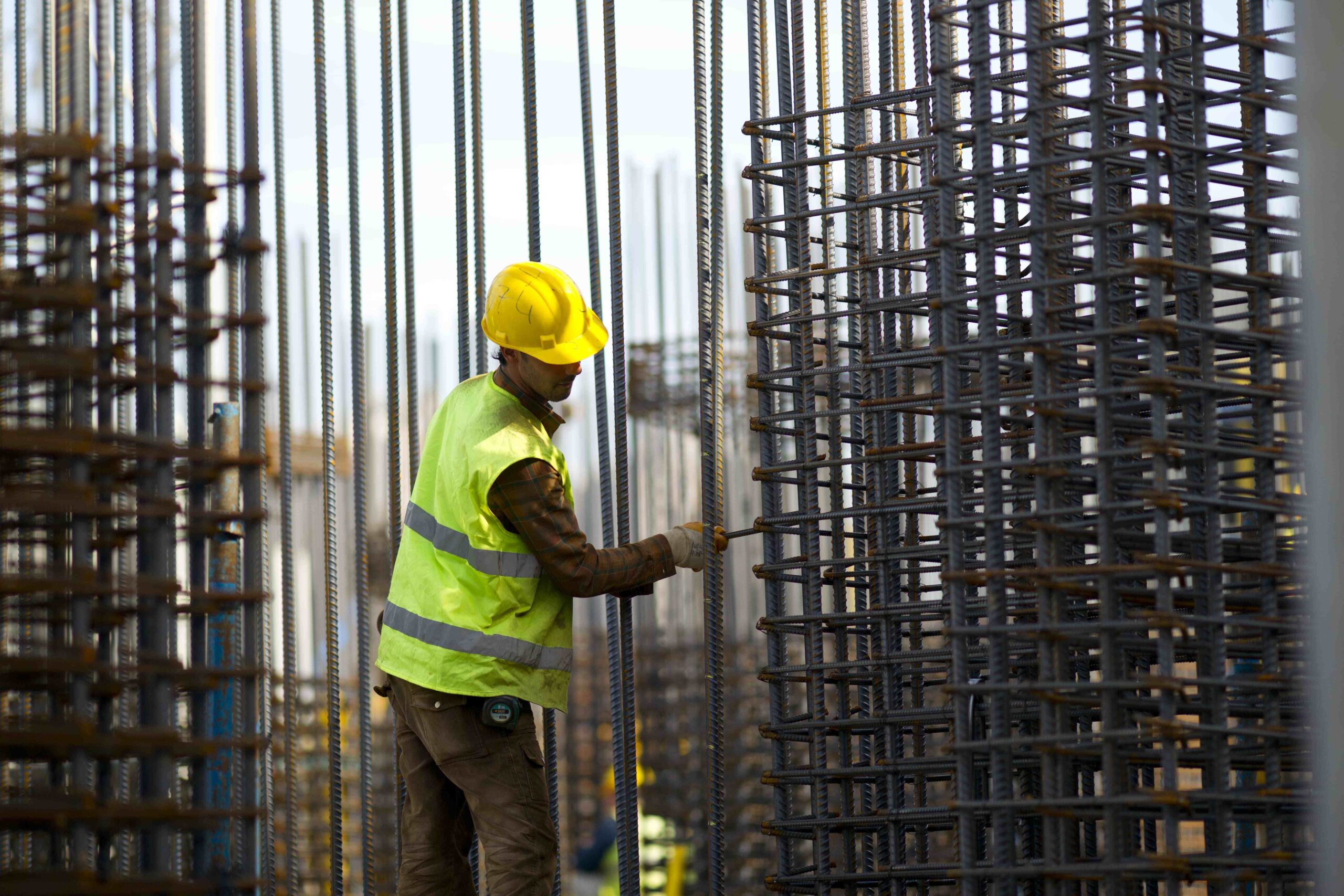
Is Your Construction Project Taking Too Long? 5 Effective Ways To Speed Up The Process
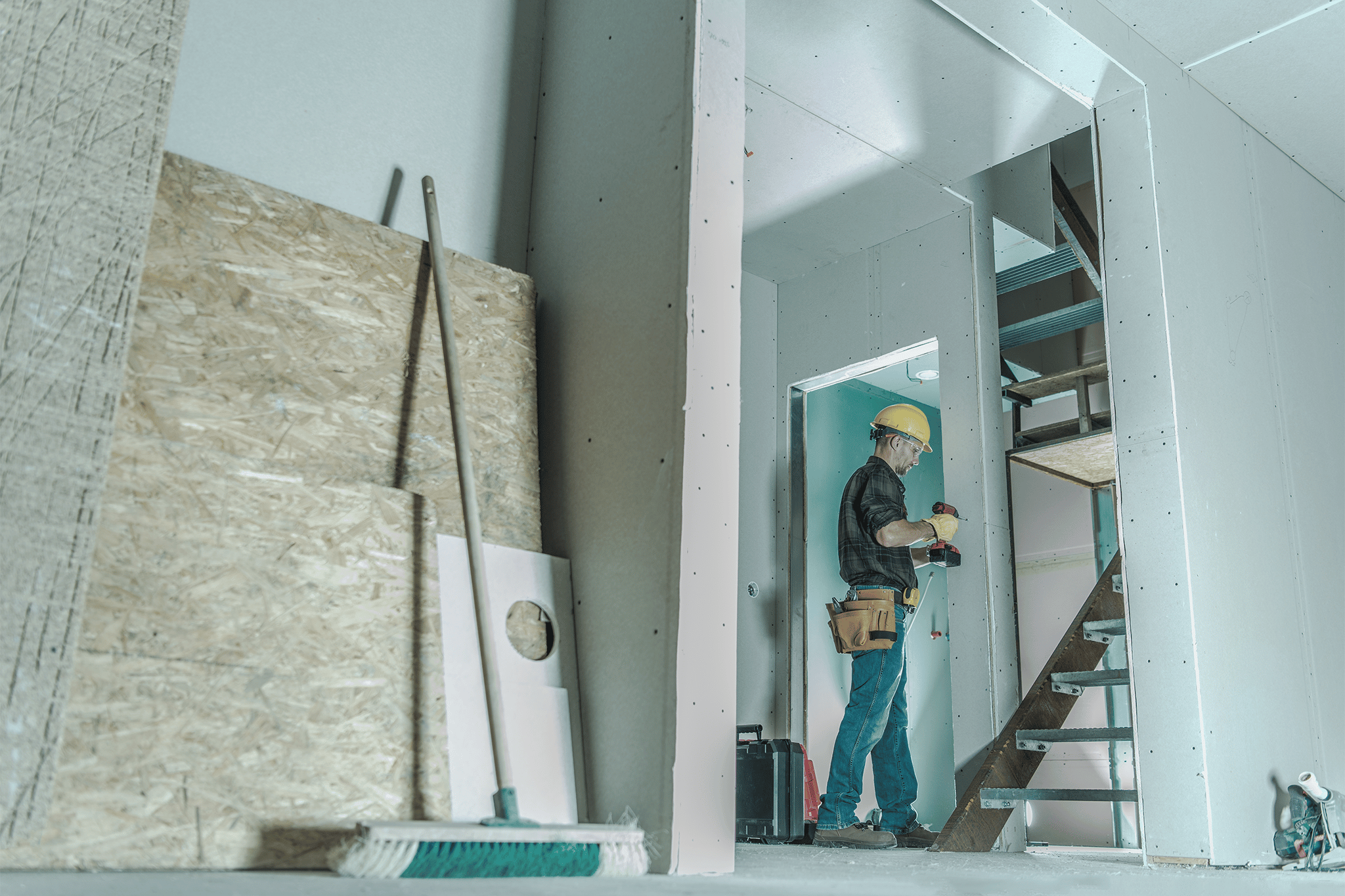
BENEFITS OF PROFESSIONAL HOME MAINTENANCE SERVICES IN DUBAI
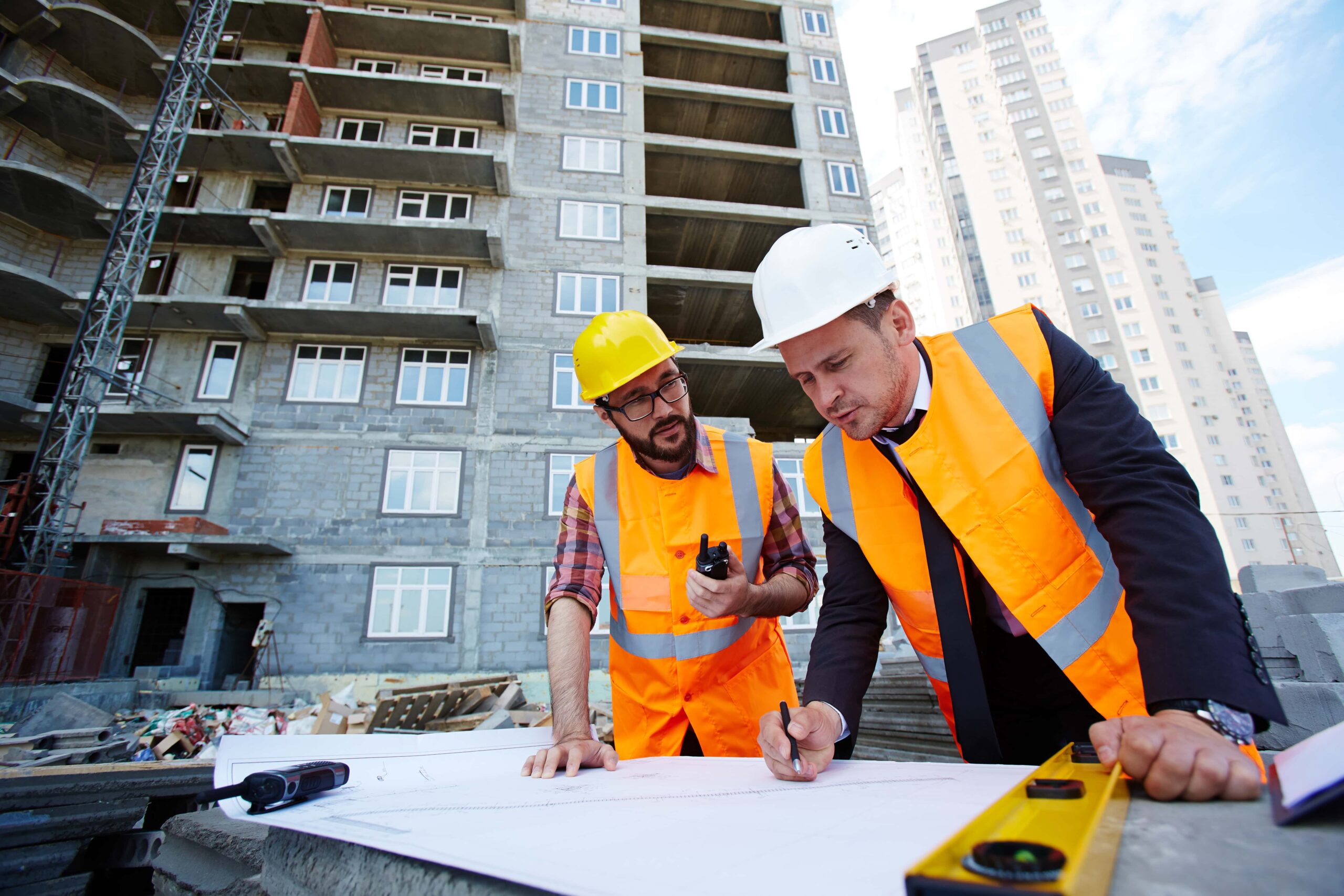
The Importance Of Planning In A Construction Project?
Ultimate Guide To Benefits Of Site Visits
Welcome to our exploration of the benefits of site visits in the construction industry, a practice integral to fostering deeper understanding and stronger relationships across all construction projects. The opportunity to see operations in action offers invaluable insights that simply can’t be captured through reports or virtual meetings. In this post, we will dive into how these visits enhance communication, identify both issues and opportunities, and significantly contribute to team collaboration, training, and public relations. Get ready to discover why making the effort to conduct site visits can transform your construction projects, leading to more informed decisions and stronger connections.
Site visits provide invaluable benefits by allowing direct engagement with construction sites. By being physically present, participants gain firsthand experience and insights that are crucial for identifying issues, seizing opportunities, and enhancing overall understanding. Additionally, site visits foster better communication, build trust among stakeholders, and boost team morale. Whether for training, compliance checks, or improving public relations, the strategic use of site visits can lead to more effective decisions and stronger professional relationships.
Real Examples of Enhanced Understanding
Case study: enhancing project outcomes through site visits, real-world examples: the value of site visits, data and research supporting collaborative working environments, industry-specific examples, real-world insights: enhancing understanding and capabilities.
- A Case Study: How Public Site Visits Boosted Nelson Builder's Public Relations
Real-World Examples of the Impact of Site Visits
Enhancing understanding through first-hand experience.
When it comes to fully grasping the intricacies of construction operations, nothing compares to the richness of firsthand experience. Site visits provide this direct, immersive exposure, allowing individuals to engage with the physical space, interact with personnel, and observe processes as they happen in real-time. This section explores how on-site engagements elevate understanding and the unique insights they can offer.
The Value of Being On-Site
Experiencing a construction site in person offers a depth of understanding that is difficult, if not impossible, to replicate through reports or virtual tours. When you step into an actual work environment, you can absorb details that are often overlooked in descriptions or photographs. The sights, sounds, and even the atmosphere of a location contribute to a comprehensive grasp of the situation that remote observation methods cannot capture.
For instance, observing the flow of operations from start to finish can reveal efficiencies or bottlenecks that might go unnoticed in a written report.
Insights Through Direct Observation
The insights gained from site visits can be profoundly impactful, influencing decision-making processes and strategies in significant ways. For example, by observing workers in their natural environment, you can identify potential areas for ergonomic improvements that enhance safety and productivity.
Visiting a site also allows stakeholders to engage directly with employees, providing a platform for open communication and feedback. This interaction can uncover hidden challenges and innovative ideas from those who are most familiar with the daily operations.
Consider a project manager in the construction industry who makes regular site visits to ensure that the project aligns with planned timelines and quality standards. During these visits, the manager might notice that the placement of materials is causing unnecessary delays. Recognizing this issue firsthand allows for immediate adjustments that improve efficiency and reduce costs.
In summary, site visits are invaluable for gaining a deep, accurate understanding of various operational aspects. They provide a level of detail and a perspective that remote methods cannot match, making them an essential tool for anyone looking to gain a true sense of how things work and how they can be improved. By embracing the power of direct observation, construction professionals can make more informed decisions, enhance operational efficiency, and drive significant improvements.

Improving Communication And Relationships
Effective communication and strong relationships are the backbone of any successful construction project, where collaboration between multiple stakeholders is essential. Site visits are a powerful tool in enhancing these aspects, offering a unique opportunity for face-to-face interactions that can significantly benefit project outcomes. This section delves into how site visits can improve communication, build trust, and strengthen relationships, alongside a real-world case study illustrating these points.
Facilitating Better Communication
Site visits allow stakeholders to communicate directly, which is far more effective than virtual meetings or traditional reports. Being on the ground not only allows for immediate feedback but also enables participants to engage with the actual elements of the project. This direct interaction helps in clarifying details that might be lost or misinterpreted through other communication forms.
For instance, during a site visit, a contractor might notice an issue with the materials being used, which could be discussed and resolved on the spot with the project manager and supplier. This immediate resolution of issues not only saves time but also reduces the likelihood of errors proliferating, which might happen if communication were to take place via email or phone calls. The hands-on approach helps in aligning everyone’s understanding of the project status and requirements, thus enhancing the overall communication flow.
Building Trust and Fostering Relationships
The personal interactions that site visits foster are invaluable in building trust among stakeholders. When people meet face-to-face, it humanizes their interactions, moving beyond the impersonal nature of digital communication. It allows for the observation of body language, tone of voice, and other non-verbal cues, which are significant components of building trust.
Moreover, regular site visits demonstrate commitment and investment to the project, reassuring stakeholders of each party’s dedication. For example, when a project investor regularly attends site visits, it reassures the project team that their efforts are recognized and valued, thereby fostering a positive and collaborative working environment.
Consider the case of a New Zealand-based construction project where the introduction of regular site visits led to a significant improvement in project delivery and stakeholder satisfaction. The project initially faced challenges with delays and miscommunication, causing frustration and mistrust among the team.
The management decided to implement bi-weekly site visits involving all key stakeholders, including the client, architects, and main contractors. These visits allowed everyone to discuss ongoing issues, assess progress in real time, and make decisions quickly and collaboratively.
The impact was profound. The project not only caught up to the original timeline but also improved in quality due to enhanced coordination. The direct, consistent communication fostered a team-oriented atmosphere, built trust, and reduced conflicts. Post-project reviews highlighted that stakeholders felt more involved and satisfied with the project process, directly attributing this change to the increased frequency and effectiveness of site visits.
Site visits play a crucial role in improving communication, building trust, and fostering strong relationships among stakeholders in any project. By providing a platform for direct interaction and immediate problem-solving, they can lead to more efficient project execution and better outcomes. As illustrated by the case study, incorporating regular site visits into the project management strategy can transform potential challenges into success stories, underscoring the power of personal engagement in achieving business goals.

Identifying Issues And Opportunities
When managing construction projects, being physically present at the site can be invaluable. In this section, we’ll explore how site visits enable project managers and teams to identify issues and opportunities that might not be apparent when working remotely.
Uncovering Hidden Issues with On-Site Presence
One of the key benefits of conducting site visits is the ability to identify potential problems that are not visible on blueprints or digital simulations. Being on the ground allows project managers and team members to get a firsthand look at the nuances of the site, which often leads to spotting inconsistencies or issues that remote surveillance technologies might miss.
For example, during a site visit, a project manager might notice that the soil composition isn’t as robust as expected, which could affect the foundation of a building. Similarly, real-time observation might reveal that a particular area is prone to waterlogging, a detail that satellite images or plans may not sufficiently disclose. These discoveries enable immediate adjustments to plans, potentially saving significant amounts of time and money.
Seizing Opportunities for Improvement and Innovation
Beyond identifying issues, site visits are also crucial for uncovering opportunities for improvement or innovation. When project leaders are physically present, they can evaluate processes, interactions, and the environment in real time, leading to insights that drive innovation.
Take the case of a construction project where a project leader notices an underutilized area adjacent to the proposed building site. By integrating this space into the project, they were able to add green recreational zones, which not only enhanced the aesthetic value of the site but also contributed to worker well-being. This strategic decision came about because the project leader could see and evaluate the space personally, something that might not have been as compelling through remote assessments.
There are countless anecdotes where site visits have led to crucial decisions that shaped project success. Consider a situation where a site visit to a new construction site revealed that the planned loading dock was too small to efficiently handle peak delivery times. By observing the site’s layout and traffic flow in person, the project manager was able to redesign the area to accommodate larger vehicles and more simultaneous deliveries, significantly optimizing operational efficiency.
Another example is from a civil engineering firm tasked with a bridge renovation. During routine site visits, engineers discovered early signs of erosion under the bridge that had previously gone undetected. This discovery prompted an immediate redesign of the water diversion system around the bridge, significantly extending its life and ensuring safety for its users.
In essence, the power of being physically present at a site cannot be overstated. While technology provides many tools for remote assessment and management, the tangible insights gained from being on-site play a crucial role in both problem-solving and seizing opportunities for innovation. Site visits not only offer a clear view of present conditions but also provide a deeper understanding of potential improvements, making them an indispensable part of effective project management.

Enhancing Team Collaboration And Engagement
In today’s fast-paced construction environment, fostering a culture of collaboration and engagement is crucial for the success of any team. Bringing team members together on a site visit can have profound effects on morale and unity, creating a more cohesive and motivated workforce.
Boosting Morale and Promoting Unity Through Site Visits
Bringing team members together in a physical space like a site visit can significantly boost morale. It breaks the monotony of the daily routine and allows team members to interact in a different setting. These interactions can be more personal and engaging compared to virtual meetings, helping to strengthen bonds between colleagues. When team members feel connected to one another, it fosters a sense of community and belonging, which is essential for a harmonious work environment.
Moreover, site visits offer an opportunity for team members to see the broader impact of their work. Observing firsthand how their efforts contribute to the project can instill a sense of pride and accomplishment. This visibility is particularly motivating and can ignite passion in team members, driving them to contribute more actively and enthusiastically to their roles.
Impact on Team Engagement and Motivation
The effect of site visits on team engagement and motivation cannot be overstated. When team members come together in a shared space, it facilitates open communication and more dynamic brainstorming sessions. These interactions can lead to innovative ideas and solutions that might not surface through digital communication channels.
Additionally, site visits can serve as a platform for recognizing individual and team achievements. Celebrating these accomplishments in the presence of peers can significantly elevate a team member’s motivation and encourage others to strive for excellence.
Research supports the notion that collaborative working environments, including regular site visits, lead to higher productivity and job satisfaction. For instance, studies have shown that employees who feel connected to their team and engaged in their work are up to 50% more productive. This increase in productivity not only benefits the company’s bottom line but also enhances the individual’s sense of worth and achievement.
Moreover, studies highlight that companies promoting collaborative working environments see a reduction in staff turnover, higher levels of commitment, and improved flexibility in working practices. These benefits stem from a culture that values open communication and shared goals, which are often reinforced during site visits.
In conclusion, enhancing team collaboration and engagement through site visits is a powerful strategy. It not only boosts morale and unity among team members but also significantly impacts their engagement and motivation. By fostering a collaborative environment, construction organizations can enjoy increased productivity, reduced turnover, and a more satisfied workforce. Implementing regular site visits can be a transformative strategy for any team looking to enhance their performance and cohesion.

Training And Educational Benefits
Site visits play a pivotal role in the construction industry, acting as a crucial tool for hands-on training and professional development. When professionals step into the field, away from traditional learning environments, the benefits are significant. This direct exposure to real-world construction sites not only deepens understanding but also enriches the professional experience by offering practical insights that cannot be replicated in a simulated environment.
The Power of Practical Exposure
One of the primary advantages of site visits is the enhancement of specific skills and knowledge that only direct exposure can facilitate. For instance, during a site visit, individuals are often able to observe processes in real time, ask questions on the spot, and engage with professionals who are seasoned in applying theoretical knowledge in practical scenarios. This direct engagement helps in bridging the gap between theory and practice.
Skills such as problem-solving, critical thinking, and decision-making are significantly sharpened during site visits. Participants learn to assess situations in a real-world context and make decisions quickly, a skill particularly valuable in the fast-paced construction industry. Moreover, soft skills like communication and teamwork are also enhanced as professionals often need to interact with peers and experts during these visits, fostering a collaborative learning environment.
Enriching Knowledge Through Real-World Application
In addition to skill enhancement, site visits provide a deep dive into specialized knowledge areas specific to the construction industry. For example, seeing a live construction site helps professionals understand aspects of project management, structural design, and safety protocols far better than any textbook illustration could.
Taking a closer look at industries that benefit immensely from on-site visits, construction stands out prominently:
Construction: Whether it’s residential, commercial, or infrastructure projects, construction professionals gain irreplaceable insights during site visits. Observing the dynamics of building frameworks, the integration of various construction materials, and the coordination among different teams provides an invaluable layer of practical education that complements their academic studies.
These real-world experiences not only reinforce theoretical knowledge but also prepare professionals for real-life challenges by providing them with a clear picture of what to expect in their respective fields.
The benefits of site visits are clear: they provide an immersive learning experience that enhances both hard and soft skills, deepens industry-specific knowledge, and bridges the gap between theoretical learning and practical application. By incorporating site visits into training programs, construction companies can significantly boost the professional development of their employees, preparing them more effectively for their future careers. This hands-on approach to learning is indispensable in fostering a deeper understanding and a greater appreciation of the construction field.

Providing Real-World Contexts To Theoretical Knowledge
Bridging the gap between theory and practice through site visits is especially crucial in the construction industry. Understanding theoretical concepts forms the backbone of educational and training programs, but the true challenge often lies in applying these theories to real-world scenarios. This is where the significance of site visits comes into play, serving as a crucial educational tool.
When construction professionals visit actual work sites, they witness the complexities and dynamics of real-life operations that textbooks and lectures can only partially convey. For instance, seeing the layering process of materials in road construction or observing real-time problem-solving on a live construction site can drastically enhance understanding. Such experiences not only clarify theoretical knowledge but also imbue professionals with a deeper appreciation of the intricacies involved in their field.
The benefits of incorporating site visits into educational and training programs are manifold. Firstly, they provide an immersive learning experience. By stepping out of the traditional learning environment and entering actual work environments, professionals can observe experts in action. This not only reinforces their theoretical knowledge but also sparks curiosity and fosters a proactive learning attitude.
Furthermore, site visits enable attendees to interact with seasoned professionals and ask real-time questions. This interaction is invaluable as it provides insights into the practical challenges and decision-making processes in the field. Such engagements can also illuminate career paths and opportunities within the industry that might not be evident from afar.
Moreover, site visits often lead to better retention of information. The sensory experience of seeing, hearing, and sometimes even participating in the work being done helps individuals remember and understand the details more effectively than theoretical learning alone. Additionally, these experiences can boost the confidence of new entrants to the industry by equipping them with a more realistic view of the workplace and its expectations.
In summary, site visits are an essential bridge between theoretical knowledge and practical application. They enrich learning, enhance professional capabilities, and prepare construction professionals for the challenges of real-world scenarios. By incorporating these experiences into educational and training programs, construction companies and institutions can significantly improve the efficacy of their learning outcomes and better prepare their charges for successful careers.

Boosting Public Relations And Transparency
Site visits have long been a powerful tool in the arsenal of construction companies aiming to enhance their public image and foster greater transparency. When managed effectively, these visits can significantly bolster the perception of a company as open and accountable, fostering a stronger connection with the community and stakeholders.
Enhancing Public Perception Through Site Visits
Site visits serve as a direct channel for construction companies to showcase their operational processes, commitment to safety, and environmental responsibility. By opening their doors to the public, companies not only demystify their day-to-day operations but also proactively engage with the community. This direct engagement helps break down barriers and dispel any misconceptions or rumors.
For example, a construction company might host site visits to display its advanced safety protocols and cutting-edge technology. Visitors get a firsthand look at the meticulous care taken at each step of production, which can significantly enhance their perception of the company’s dedication to quality and safety. This transparency is crucial in building trust; when people see for themselves the inner workings of a facility, their confidence in the projects and the company generally increases.
The Role of Open Days in Demonstrating Transparency and Accountability
Open days or public site visits are particularly effective in demonstrating a construction company’s transparency and accountability. These events are typically well-organized, with guided tours, demonstrations, and Q&A sessions that provide visitors with comprehensive insights into the company’s operations.
During open days, companies have the opportunity to interact directly with visitors, addressing any questions and concerns they might have. This open line of communication is vital for accountability. It shows that a company is not only willing to discuss its processes but also to listen to and act on feedback. Such interactions emphasize a company’s commitment to continuous improvement and ethical practices, reinforcing public trust.
A Case Study: How Public Site Visits Boosted Nelson Builder’s Public Relations
A remarkable instance of the positive impact of public site visits on public relations can be seen in the case of Nelson Builder, a construction firm facing initial public skepticism about the environmental impact of its operations. Nelson Builder initiated a series of open-day events that were specifically designed to educate the public about their projects and their benefits.
These site visits included tours of their construction sites, demonstrations of the technology, and open forums for discussion. The transparency and eagerness to educate dispelled myths and built a strong community rapport. Following these events, public opinion shifted positively, with increased support for the company’s projects and a notable rise in local partnerships.
The success of Nelson Builder highlighted how effectively managed site visits could lead to a substantial improvement in public relations. It demonstrated that when a construction company takes proactive steps to open its doors and transparently share its operations, the public’s trust and support can be earned.
In conclusion, site visits are a crucial strategy for any construction company looking to improve public perception and demonstrate transparency. By allowing the public an inside look at their operations and maintaining an open dialogue, companies can build trust, dispel doubts, and foster a positive relationship with the community. The case of Nelson Builder serves as a testament to the power of well-executed site visits in turning public opinion around and enhancing overall public relations.

Compliance And Safety Verification
Ensuring compliance and verifying safety standards are critical aspects of operations in the construction industry. Regular site visits are not just routine checks; they are fundamental practices that safeguard the integrity of construction projects, ensure legal adherence, and uphold ethical standards. This section explores the importance of these visits and the implications that they have on both a legal and ethical level.
The Importance of Regular Site Visits for Compliance Checks
Compliance with industry standards and regulations is a cornerstone of successful construction operations. Regular site visits allow for real-time monitoring and assessment of ongoing practices against these established norms. For industries like construction, where safety and precision are paramount, such assessments are crucial. They help identify deviations and non-compliance issues that might otherwise lead to severe penalties or operational shutdowns.
These visits serve a dual purpose. Firstly, they ensure that all operations are aligned with current laws and regulations, which can often be subject to changes. Staying updated through frequent inspections helps businesses adapt quickly to new requirements. Secondly, they demonstrate a company’s commitment to lawful operations, which is vital for maintaining licenses, certifications, and public trust.

Legal Implications of Regular Site Inspections
Legally, the failure to conduct regular site inspections can lead to significant consequences. Regulatory bodies are empowered to impose fines, sanctions, or even criminal charges depending on the severity of non-compliance. For instance, in the construction industry, lapses in compliance can directly affect public safety, thereby attracting stricter scrutiny and heavier penalties.
Moreover, regular site visits are sometimes mandated by law. In such cases, failing to conduct them is not just a breach of internal protocols but a direct violation of legal requirements. This could also lead to legal battles that drain resources like time and money and harm the organization’s reputation.
Ethical Considerations of Site Inspections
Ethically, regular site visits reflect an organization’s commitment to integrity and ethical business practices. They ensure that the health and safety of workers and the general public are protected, a responsibility that every construction business must prioritize. In many cases, ethical business practices foster a positive work environment, leading to increased employee satisfaction and retention.
From an ethical standpoint, regular inspections also demonstrate transparency and accountability. They show that a company is not only committed to following the law but is also proactive in its efforts to go beyond what is legally required to ensure safety and compliance.
Consider a construction company that implemented a strict schedule of regular site visits to ensure compliance with new safety regulations. These visits not only prevented potential safety incidents but also improved the company’s reputation for safety, leading to more project bids and higher client trust.
Another example involves a construction project where site visits uncovered that the materials being used were substandard and not in compliance with the specified requirements. Immediate corrective actions were taken, which not only saved the project from potential failure but also upheld the ethical standards of the company, reinforcing its reputation for quality and reliability.
In summary, regular site visits for compliance checks and safety verifications are more than just a regulatory formality—they are a critical component of responsible construction management. These inspections help prevent legal issues, promote ethical practices, and maintain high standards of operation. For construction businesses looking to sustain and grow their operations, understanding the importance of these practices and implementing them effectively is essential. By ensuring regular and thorough site visits, construction companies can safeguard their projects, protect their workforce, and maintain the trust of clients and the public.

FAQs: About Benefits Of Site Visits
A site visit involves physically going to a location to observe and understand its operations and processes firsthand. It’s important because it provides real insights and a deeper understanding that cannot be achieved through remote methods like video calls or reports.
Site visits allow for direct, face-to-face interaction among stakeholders, which can lead to clearer and more effective communication. They also help in building personal connections and trust, which are crucial for successful collaborations and negotiations.
During a site visit, one can identify operational issues, safety hazards, inefficiencies, and other problems that might not be apparent in reports or during remote monitoring. This direct observation enables timely interventions and solutions.
Yes, by providing a deeper understanding of the processes, site visits can help uncover opportunities for optimization, innovation, and improvement that might otherwise remain unnoticed.
Site visits can strengthen team bonds by bringing members together in a shared environment, which can enhance collaboration and foster a sense of unity and purpose. They also provide a break from the usual routine, which can be refreshing and motivating.
For educational or training purposes, site visits offer practical, real-world experiences that enhance theoretical knowledge, making learning more engaging and effective. They help students and trainees understand how theories apply in real settings.
Open site visits show a company’s commitment to transparency and accountability, improving public perception. They allow stakeholders and the public to see operations firsthand, which can build trust and enhance the company’s image.
Regular site visits are essential for ensuring compliance with industry standards and safety regulations. They provide an opportunity to conduct thorough checks and verify that all operational practices and safety measures are being followed correctly.
The frequency of site visits can vary depending on the industry, the complexity of operations, and specific project needs. However, regular visits are recommended to ensure continuous oversight and engagement.
Preparation should include a clear agenda, a list of specific areas or issues to inspect, necessary safety equipment, and a team of relevant experts if needed. It’s also beneficial to inform site personnel in advance to arrange necessary access and support.
In wrapping up, it’s essential to revisit the significant advantages that site visits offer. From enhancing real-time understanding of project status and fostering stronger team collaboration to allowing for immediate feedback and better risk management, the benefits are manifold. Given these substantial gains, businesses and educational institutions alike should seriously consider making site visits a regular part of their operational or educational strategies. Doing so can lead to more informed decision-making, enhanced efficiency, and ultimately, greater project success. We encourage you to take this step forward—integrate site visits into your routine and witness firsthand the positive transformations they bring to your endeavors.
About The Author
David baker, related posts.
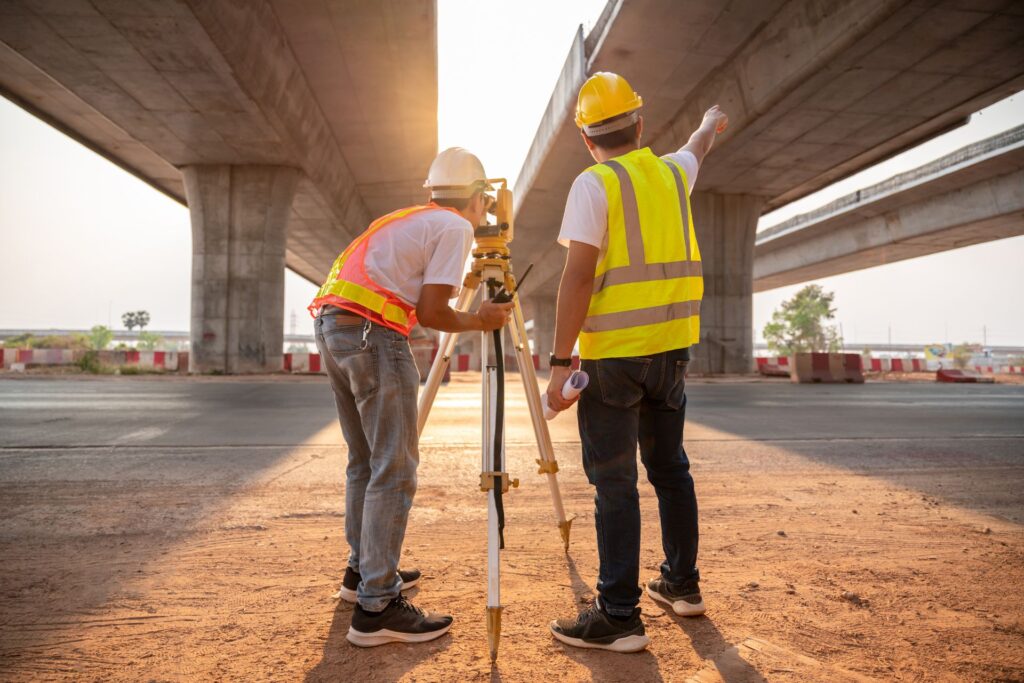
The Ultimate Guide To Cost Of Quantity Surveyors NZ
Welcome to our comprehensive guide on navigating the costs of quantity surveyors in New Zealand, a topic of paramount importance for anyone involved in the…
Read More »

Ultimate Guide To How To Send Quantity Reports To Close More Clients
Welcome to our comprehensive guide on how to send quantity reports to close more clients. In the world of business, clear and precise communication can…

Renovating/Extending Vs New Build
Renovating/Extending Vs New Build Here are some insider tips on why home renovations and additions can be more trouble than a new build. Renovations and…
From the Blog
See and be seen: the mutual benefits of school site visits.
- February 26, 2020
by Craig Kesselheim

The third-grader was standing beside a table in the noisy art classroom, ready to explain the tangible evidence of her learning. In one hand was a mummy, a doll-sized figure wrapped thoroughly in white plastered fabric. On the table was a sarcophagus rendered from a shoebox. The young learner explained that she had been dedicating her recent “Genius Hour” time to learning more about the history of mummification. Her mummy was a repurposed Barbie doll, but the hieroglyphics on the shoebox, we were told, had historic validity. She glowed as she informed her visitors about the process and her learning.
I was one of those visitors. I was accompanying a school team as their school coach while they conducted a two-day site visit to a district they had identified as being aspirational to their own system’s evolution. The team of four—two administrators and two teachers—visited classrooms in three schools. They conversed with students, met teachers before and after school, and studied artifacts for two solid days. Each evening, as they shared snacks and drinks, they made sense of their findings and explored the implications for their own system back home.
Beyond your own parking lot
The benefits of conducting a school site visit are powerful. Our discourse and our designs are too frequently limited by the boundaries of our hyper-local geography. We talk to our immediate colleagues. The school team I accompanied had the wisdom to realize that their own innovative thinking was limited. If we could think of every American school system as an innovation lab (some more effective than others), school site visits allow us to scout the collective brainstrust and receive new inspiration and technical how-tos. Consider the costs of not looking beyond our own parking lots: for students, who may not experience the benefits of effective practices observed elsewhere and applied back home; for classroom teachers, who might lose the opportunity to be inspired to try new things in class; and for school leaders, who might not discover a powerful and supportive school structure.
A two-way street
As our visiting team stepped into classrooms, huddled with principals and teacher leaders in conference rooms, absorbed the hum in media centers, and took numerous pictures of school artifacts, we also learned that our hosts were fellow learners. The lists of classroom “look-fors” they gave us were our opportunity to help them ground truth their own journey. They asked us to identify places where those “look-fors” were in evidence and times when they appeared absent. They wanted our feedback to be critical and constructive, not superficial or cordial. The questions we posed to them created meta moments when they could reflect on their “why.”
The things visitors notice are of keen interest to the host school, and sometimes can be surprising. School site visits often provide an “everyone wins” experience. It was clear to us, for example, that student engagement (student joy , actually!) was high during Genius Hour and Exploratory time. But because we probed more, we learned that the school had evolved from teacher-selected topics to student-driven topics. In other words, the school asked students what they wanted to learn and then allocated adults across the building to make that possible. Our questions helped the school identify and celebrate this truly notable commitment and also created the space for host teachers to name some of the kinks that still needed to be addressed.
Making the most of your visits
Site visits can be successful and fruitful with a bit of thoughtful prior planning. Because they are relatively infrequent for any given district, and because they come with the costs of lost instructional time and travel expenses, your plans should begin in advance. For the sake of brevity, here are a few suggestions based on a variety of site-visit experiences I’ve had over the last 15+ years of school coaching. You may also want to download the Great School Partnership’s Learning in Action – A Guide to Conducting High-Impact School Visits .
Suggestions
- Go near, or go far. School site visits may be as close to you as your own district. A high school team can glean many insights by visiting one of their sending middle schools. Many school systems build intra-district visits into their annual routines. Alternatively, school site visits may be across your state or elsewhere in the country.
Example from my experience: Our visiting team was preparing for a rare event: the merging of two elementary and one middle school into one brand new pK – 8 building. They work in a remote corner of a rural state. Their daily network consisted of districts that looked and acted much like themselves. They knew they had to travel beyond their region.
- Define, then share your purpose. A host school is better equipped to plan your itinerary and select artifacts to see and teachers to meet when the host school knows what you hope to learn.
Example from my experience: Because our visiting team was planning ahead for a newly-constructed K – 8 building that would combine grades and faculties, they wanted to see innovative, student-centered pedagogy, flexible student grouping, multiple pathways, and a well-functioning middle level advisory. Conveying these needs ahead of time was crucial to the design of our two days.
- Notice everything. What is entering the school like? Who is the first person to shake your hand and welcome you? How are the reception area and principal’s office arranged? What do you hear? Whose voices? What tones and moods?
Example from my experience: We were greeted by children and they held doors open for us. The school receptionists stepped away from their desks to welcome us, thank us for visiting, and shake our hands. The principals’ conference rooms were furnished for comfort, not like board rooms. The classrooms were humming with student voice and purposeful energy. For some in our visiting party, these acts of culture were as powerful and important as seeing children thriving in the Genius Hour and seeing teachers connecting with children in advisory periods.
- Suspend judgment; enter with inquiry. It is common to encounter things outside of our own experiences during school site visits. This can shut us down from further learning if it leads to reactions such as “these kids aren’t like our kids,” or “it must be nice to work in such a shiny building,” or “well, if I had only 16 children in my classroom…” Remember that a site visit is designed to challenge our thinking, to find transferable models, or even to learn a valuable lesson from an imperfect example. Site visits move our practice as well as our thinking. Sometimes site visits serve to provide more clarity about what we already do well.
Example from my experience: Our visiting team entered a district where schools must market themselves to compete for attendance from nearby schools, abutting districts, and charters. While this was completely irrelevant to their local context, our team gained powerful insights about the importance of communicating to and partnering with the parent community.
Our visiting experience was rich, informative, and memorable. The team took stock of their observations, highlighting the most share-worthy takeaways and considering implications for their colleagues back home. The girl with the mummified Barbie made an impression that went far beyond her humorous-yet-earnest project. We saw her example replicated across the school and were deeply impacted by the host school’s commitment to student-centered learning. We headed for home thinking hard about how to bend, re-imagine, innovate, and inspire in this new school under construction. And that would not have happened without leaving the safety of our own parking lot.
482 Congress Street, Suite 500 Portland, ME 04101 Phone: (207) 773-0505 Fax: (877) 849-7052
©2024 Great Schools Partnership

Meridian West Consultants
The importance of attending site visits.
Assuming you know what a construction site looks like, or that you understand the entire Request for Proposal (RFP) package is a big mistake. Make no assumptions and learn all you can about the site and the solicitation before putting your hat in the ring. This means attending Site Visits!
The purpose of Site Visits is to allow offerors to obtain a better understanding of site conditions and the work required, as well as gather quality information about the solicitation and familiarize yourself with the procuring agency. Site Visit information is stated in solicitation documents and can be either mandatory or optional, they are usually held a few weeks after the solicitation has been issued and a few weeks prior to submission due date.
Attending site visits, weather mandatory or not, has many benefits and can provide an advantage in the proposal preparation process. Joining in on Site Visits gives offerors opportunities like these:
Evaluate ability to meet solicitation and project requirements
Converse with procuring agency to obtain knowledge about best practices regarding administration and the site
Understand site conditions and upcoming challenges and adapt a suitable plan
Determine accurate resource and material allocation
Comprehend scope of work to better create the bid price
Ability to gather questions regarding the site or proposal preparation so you can formally ask according to solicitation instructions
Contact Meridian West to help you get registered for the site visit. We can also help you create and submit your questions afterwards. Attending Site Visits will add value to the proposal preparation process as well as the overall project performance. It can be the first step to a successfully completed project.
We've laid out a list of Pro Tips to help you make the most of every site visit below.

Pro Tip #1 : Prior to visiting the site, review solicitation documents including scope of work, drawings, designs, as well as proposal submission and evaluation criteria. This will help you understand what specific questions you have about the site and can help you assess where you should focus your attention. Reviewing these documents will also help you gather initial questions that you might have the opportunity to get answered at the visit.
Pro Tip #2 : Take as many photos of the site as possible. Photos will be a good reminder of certain aspects of the site when you are preparing your technical proposal or developing a price. Pay special attention and take extra photos of areas of the site that might provide potential problems or concerns.
Pro Tip #3 : Once you have visited the site and formed all the questions you have it is important to ask them according to solicitation requirements and in a timely manner, at least by the required deadline, if not, sooner. It’s also beneficial to form questions in a way that is easy for Contracting Officer’s to answer, if possible, a simple yes or no answer.
Recent Posts

NAICS Codes – Your Company Identity and Small Business Size Standards

Create More Business – Through a Joint Venture: A Joint Venture To-Do Checklist

Happy 20th Anniversary to Meridian West Consultants, LLC!

Consultant Spotlight - RaNae Schmidt

How to Register A New Federal Contracting Company and Find Opportunities with beta.SAM.gov

The Long-term Effects of COVID-19 on Government Contractors

Alaska Native Corporations and the Federal Construction Market – How to Help and How to Benefit

Impacts and Projections for Small Business Contractors in 2021

Understanding and Explaining Safety Records for an RFP Response

Stand Out in the Crowd - The 4 Step Process to Building a Resume

- Team Members
- Justice, Equity, Diversity, and Inclusion (JEDI) Statement
- Focus Areas
- Our Approach
- Clients and Funders
- Join Our Team
- Research and Evaluation
- Evaluation Capacity Building
- 10 Steps to Creating an Infographic
- Mindful Leadership
An Evaluator’s Guide to Performing Successful Site Visit Observations
For external evaluators, site visits (e.g. visiting schools) provide an opportunity to experience the activity, program, or product first-hand while also offering a chance to connect in-person with participants from a study. As these observations provide an important addition to report findings, Magnolia Consulting follows several steps for successfully navigating site visit observations. Based on our experience, here are five key guidelines for successful site visit observations:
- Conduct an in-person study orientation. Conducting an in-person study orientation before site visits offers the opportunity to meet and interact with participants, which helps to establish a trusting relationship. Having a positive rapport with participants is important as it allows for open communication and can help reduce any participant concerns associated with site visit observations. During the study orientation, inform participants of details about the purpose of the site visits, expectations for participation, and how site visits will be scheduled to minimize disruption in the classroom. During the orientation, explain how the data will be used and how evaluators will maintain participant confidentiality. If the budget does not allow for an in-person orientation, webinars with video access are also a helpful tool to introduce yourself to the participants.
- Create an observation protocol. Using an observation checklist or protocol helps to reduce bias associated with observations and assures that preestablished guidelines are followed. These protocols typically focus on the quality and extent to which an activity, program, or product is implemented and/or aligned to best instructional practices in the field (i.e., reading instruction, STEM). If multiple evaluators perform observations across participants or sites, the measure should be checked across observers for agreement and accuracy.
- Enlist a site coordinator . If budget allows, plan for having an on-site coordinator who knows the site’s participants and inner workings. This individual can communicate with the evaluation team’s program coordinator on details throughout the study such as scheduling observations across multiple participants at the site. Furthermore, the site coordinator can communicate details with participants before the observation and answer any questions that arise. In addition to coordinating site visit observations, the site coordinator might be responsible for other helpful tasks such as managing consent forms and ensuring assessments are distributed and returned in an organized manner.
- Be flexible with scheduling. Allowing flexibility and accommodating a site’s scheduling needs supports understanding and recognition of “real world” complications. If possible, create a schedule that follows the site’s established routines. This may require conducting observations across several days rather than consolidating multiple sessions into a shorter timeframe. If the evaluation budget is limited and requires observations to be performed within a brief period, work with the site coordinator to determine another mindful, yet suitable schedule. If appropriate, send participants a direct email one week prior to the visit restating the purpose of the observation and confirming the schedule. This can help avoid an observation from being unannounced.
Share This Story, Choose Your Platform!
About the author: molly henschel.
- Meet the team
- Manchester Office
- London Office
- Bid Writing Ad-hoc bid writing
- Bid Ready Helping you prepare
- Bid Improvement Improving your win rate
- Bid Mentor Your second pair of eyes
- askabidwriter.com
- Construction Testimonials
- Consultancy Testimonials
- Creative Testimonials
- Education Testimonials
- Environmental Testimonials
- Facilities Testimonials
- Healthcare Testimonials
- Hospitality Testimonials
- Recruitment Testimonials
- Research Testimonials
- Technology Testimonials
- Transport Testimonials
- Bid Writing Resources
- Bid Management Resources
- Bid Management Guides
- Tendering Process Guide
- PQQ Tender Writing Resources
- RFP Response Guide
- Social Value Guide
- Bid Training
- Tendering for Contracts
- Writing Winning Bids
- Professional Bid Writers
- PAS 91 Guide
- Hudson Helpline
- Free Courses & Certifications
- What is a Bid Writer?
- Bid Improvement
- Bid Writing
- Tendering Opportunities
- Bid Management Guide
- Bid Management Resouces
- Meet The Team

Site Visits – What Are They and How Can I Benefit?
30th january 2019.
Table of Contents
What is a Site Visit?
Last updated: Jun 7, 2022 @ 3:56 pm
Site visits are a component of the tendering process . They involve visiting the site where you are hoping to deploy your services, for the purposes of gaining in-depth information.
Are site visits common?
Within certain sectors, yes. Site Visits are not a universal aspect of tendering. You may find on one tender that it is compulsory to attend a site visit, for another that it is optional and for another, it is not offered as a possibility. This is yet another reason for reading the tender documents thoroughly. Not all tender documents are laid out in the same way. The information pertaining to potential site visits could be buried in an unlikely section of your documents.
Why do we need site visits?
Depending on the sector that you are tendering within, site visits may or may not be integral. If you work in Construction , Energy, Facilities Management or similar, then site visits are incredibly important for the following reasons:
Information gains
- Site visits pose a valuable source of information that you may not get from the tender documents .
- They present an opportunity to get detailed information from people who are knowledgeable about the site.
Accurate pricing
- If you are required to submit a pricing document, site visits give you the chance to gain meaningful information that you would never be able to glean from just the tender documents or internet searches. This will allow you to produce a realistic pricing strategy , preventing you from erroneously pricing too high or too low.
Better quality responses
- Site visits are invaluable for gathering details that will strengthen your quality responses, especially those that focus on Health & Safety, Contract Implementation and Risk Assessment & Mitigation.
- You can clarify any doubts that you may have about the information provided in the tender documents. This will again help you in your journey towards the completion of a detailed, competitive tender submission .
Site visit outcomes
There are several things that can happen as a result of a successful Site Visit.
- You could simply come away with more information to include in your tender submission , which is always a fantastic result.
- You may find that the tender deadline is extended if enough doubts, queries or clarifications are raised during the visit that causes the Buyer to consider releasing updated tender information.
How do I make the most out of my site visit?
Fortune favours the prepared. Before you go on your site visit, make sure you have covered the following points:
- Know as much about the Buyer as you can before you go. This will mean that you don’t waste valuable time asking questions that you could already know the answers to.
- Make a list of all the information you need to learn and take it with you. You might be confident that you have enough information about H&S requirements, but that you need a lot more information to help with pricing.
- Be confident and ask questions, even if you think the answer is probably obvious. Showing engagement throughout the site visit will stand you in good stead if you end up making it through to a Presentation Stage.
- Look for visual clues. You will be able to tell a lot about the Buyer and their work culture, especially regarding everyday H&S matters. This information could help you write a tender that emphasises areas you realised are more important to the buyer than others.
In conclusion
If you are hoping to supply a service that is deployed on a buyer’s site, then site visits are an unmissable opportunity to gain detailed, relevant information that could give your tender the defining edge. Don’t see them as an exercise in futility, but an opportunity to gain the upper hand over your fellow tenderers. If you ask smart questions, pay attention to the environment and embed as much of the information gained into your submission as possible, you will find that the quality of your tender submissions can grow exponentially. Partaking in a site visit can help you write a winning bid when tendering for contracts .
For more information or help with tender writing , please contact our Bid Writers and bid management consultants.
To find tender opportunities in your industry see our sector-specific tendering portals HERE .
Are you looking to learn more about tendering and procurement? See Tender VLE for our free, online, masterclasses.
Find more helpful tips and advice in our blogs. We cover topics including:
- How to win a tender
- The tendering process
- Writing winning bids
- 7 tips for tendering for contracts
- Tips for bid management
- Bid writing services
- The types of tendering procedures
- Writing bids
- Bid writing consultants
- Submitting a tender response
- And many more .
Share This Insight
Contact a bid writer.
- The Complete Guide To Writing Winning Bids In The UK
- The Benefits Of Outsourcing Bid Writing for Large Enterprises
- A Beginner’s Guide to Bid Tracking and Tender Alerts
- 5 Common Mistakes In Tender Writing And How To Avoid Them – Part 2
The Importance of Cultural Awareness in Bid Writing and How Hudson Outsourcing Embraces It
Innovative techniques for storytelling in bids: how hudson outsourcing has mastered the art for over a decade , navigating international bids: tips for global tender success.
- Transforming Data Into Insights: Innovative Approaches To Market Research For Bids
- Integrating Design Thinking Into Bid Writing: A Fresh Perspective
Overcoming Common Pitfalls in Joint Venture Bid Writing: Insights from Hudson Outsourcing
Leveraging data analytics for improved bid success rates , managing high-volume bids: time-saving tools and techniques.
- AI bid writing – The Future of Bid Writing: Trends and Predictions for 2025
- How to Effectively Integrate Sustainability into Your Bid Proposals
- Adapting Bid Writing Strategies for Emerging Industries
- Hudson Outsourcing Celebrates Milestone: Supporting 3,500 UK Businesses with Unmatched Success in the Healthcare Sector
- Askabidwriter.com Celebrates Success: Supporting Hundreds of Companies and Driving Growth for Hudson Outsourcing
- Welcome Priyasha and Kai to the Team as Our New Bid Writers!
- Global Perspectives: How Tendering Practices Differ Around the World – Our International bid writers compare
- Hudson Secure Another Tender! Rawi Care UK
- Hudson Secure Another Tender! Recruit 4 Care Ltd
- Hudson Secure Another Tender! – Frontline Healthcare Professionals Ltd
- Hudson Secure Another Tender! – Agape Medical Health Care Ltd
- Hudson Secure Another Tender! – West Wales Action for Mental Health
- Tendering Process for Technology Contracts
- Win Tenders in the Hospitality Sector: Laundry, Catering and more!
- Tender VLE: Our Virtual Bid Learning Environment
- How to Win Healthcare Tenders: Our 10 Top Tips!
- How to Become a Tender Expert
- Top 10 Tendering Secrets
- Easy Tendering Mistakes and How to Avoid Them
- Tendering in the Creative Sector
- Public Sector Frameworks: Everything You Need to Know Before You Apply
- Bid Writing Specialists
- Legal Services Tenders
- Tender Compliance: What does it mean to be non-compliant?
- The Do’s and Don’ts of Tendering
- Tender Management: Definition, Good Practice and Our Services
- National Lottery Bids
- Tendering Process in Construction
Similar Insights

The Importance of Cultural Awareness in Bid Writing and How Hudson Outsourcing Embraces It In…

Innovative Techniques for Storytelling in Bids: How Hudson Outsourcing Has Mastered the Art for Over…

Navigating International Bids: Tips for Global Tender Success In today’s interconnected world, businesses are increasingly…

Overcoming Common Pitfalls in Joint Venture Bid Writing: Insights from Hudson Outsourcing Joint venture (JV)…

Leveraging Data Analytics for Improved Bid Success Rates How Hudson Outsourcing is Leveraging Data Analytics…

Managing High-Volume Bids: Hudson Outsourcing’s Experience and Capabilities In the fast-paced world of procurement, managing…

Let’s get started.
Call for a FREE consultation with our Tender Writing Consultants or simply send us an email and a team member will contact you.
Request a Callback
- Bid Resources
- Bid Writing Testimonials
Privacy Overview
- Experiences
8 Top Benefits of Pre-Event Site Visits (plus expert tips!)
- Experience Agency Blog

- 28 September, 2017
- by Summy Lau
- in meeting planning
When it comes to planning the perfect meeting, what's the most important step? Booking the entertainment? Recruiting corporate sponsors? Creating a finely tuned agenda?
The foundation of any event is the setting , and there is no substitute for scouting out potential locations in person . Yet all too often, event planners are asked to justify the expense of a site visit or site inspection.
In today's post, learn 8 reasons site visits are critical to your event's success , plus tips to get the most out of your visit.
Benefit #1: Understand the spatial dynamics of the location.

"A misunderstanding of the location led to unhappy guests and unhappy clients."
You don't want to rely on third-party information while planning a meeting, only to have your idea of the venue end up being different from reality.
"Had the client gone on a trip out to the site and experienced the dinner, they would have said, 'This is not for us. Our executives will not like this at all - let's find something else'," Davie adds.
On a site visit, check the distance and travel times between all essential locations , during peak (rush hour) and non-peak times. Important sites include:
- Restaurants and meal locations
- Venue / hotel
- Guest rooms
- Meeting space
- Scheduled and suggested activities
Benefit #2: Discover new opportunities.

Not only do site visits prevent logistical problems, they also open up new opportunities.
When planning your meeting, you can (and should) do plenty of remote research. You'll most likely look up activities online, call the hotel concierge for recommendations, check Yelp and more.
But when you're sitting in the hotel bar, next to someone who has lived in the area for 20 years, and they talk about an amazing restaurant down the street... well, those unexpected details can end up being the most memorable part of the meeting.
The best options for your group, don't always come up in an online search . If an opportunity comes up while you're on a site visit, you're still free to make changes to your itinerary to the site visit and say, okay, let's check out this place because a local was raving about it.
Keep your eyes and ears peeled for opportunities to improve your meeting, especially with points of local interest that can't be enjoyed anywhere else in the world.
Benefit #3: Know what guests can expect.

Fact is, hotel properties are known to photograph very well. What you see on the site or in brochures may be significantly more polished than what it looks like in real life. Had the event planner just booked the property sight unseen, it would have fallen well short of what guests would likely be expecting. Thankfully, the site visit was conducted well before moving futher with plans.
"Since we were already in the area, we made appointments with other nearby properties," adds Davie. "We will be booking with another property that has everything on their wish list."
From the moment you walk in to when you leave, take note of your first impressions . Walk through as many areas your guests will visit as possible. Check different types of guest rooms.
Benefit #4: Customize for your audience.

Put yourself in your typical guest's shoes- then make the most of a two-day site visit.
- Don't just see one hotel. If there are multiple hotels within your destination and price range, stay in a different hotel each night of the visit. This gives you an actual sense of how the staff works, and the level of service they are likely to provide.
- Schedule different meals at the various restaurants where you may be looking to host a dinner or reception.
- Try out the activities you'll be offering or suggesting. You want to know how much time each activity takes and allot space in the program accordingly. What you estimated to be a 3-hour dinner cruise, for example, may end up only taking 1 hour.
Benefit #5: Meet potential vendors.
Building good rapport with the vendors executing your meeting (hotel event managers, speakers, caterers and more) is important. If you have questions, last-minute changes or difficulties, a good relationship makes it easier to get help. After all, you'll have a direct line to the right contacts if - and when - questions come up.
Plus, planning a meeting requires a lot of emails to be sent back and forth. Meeting in person puts faces to names that will be whirling back and forth when the event date approaches.
Meet as many key contacts as possible, and keep track of their contact information. Follow up after the site visit to thank them for their time and ask any questions you may have.
Benefit #6: Show a high level of interest.

You know what to expect, you've seen the quality of the venue, and you know the location will work for your event.
It's no secret that planning meetings and events is a stressful job. The less unknowns, the better... and that kind of assurance will pay off handily when all is said and done.
#8: Get the most out of your event.
Finally, the success of meetings is typically evaluated by ROI, or return on your substantial investment. To maximize ROI, you want to get the most out of your destination as you can.
Site inspections add even more value to working with a full-service meeting planning provider like Winspire. As meeting planning professionals, we facilitate the entire site visit itinerary from start to finish.
"We check with clients on availability, then schedule the flights, book arrangements with the hotel, make all the appointments, take care of transportation, and keep everyone abreast of the schedule," Davie says. "We let vendors know about the group, how many rooms we need, how many we'll have for dinner, how many will be participating in activities like golfing or kayaking... We go with clients from one appointment to the next, introducing them to vendors, then negotiate rates."
Since the vast majority of Winspire clients elect to do a site inspection, we have years of experience making the most of preliminary visits. Click below or leave a comment to begin brainstorming your next meeting.

Subscribe to Email Updates
- incentive travel (15)
- employee incentive (8)
- meeting planning (8)
- incentive program (5)
- corporate hospitality (3)
Recent Posts

©2019 Winspire | Inspired Experiences | Privacy

Evaluation Site Visits – Seeing is Knowing
- Posted on April 3, 2019
- In Data Collection , Evaluation
Gathering evaluative information about a program or initiative often relies upon evaluators physically visiting the program’s location in order to observe program operations, to collect evidence of the program’s implementation and outcomes, and to interview staff and program participants. The empirical and observational nature of site visits offer evaluators a unique lens through which to “see” what the program actually is, and how it attempts to achieve the desired outcomes it hopes to achieve.
In their influential article, “Evaluative Site Visits: A Methodological Review,” American Journal of Evaluation, Vol. 24, No. 3, 2003, pp. 341–352, Lawrence, Keiser, and Levoie note that, “An evaluative site visit occurs when persons with specific expertise and preparation go to a site for a limited period of time and gather information about an evaluation object either through their own experience or through the reported experiences of others in order to prepare testimony addressing the purpose of the site visit.” Unlike case studies, which are of longer duration and often of greater depth, and which seek to describe in detail the instance or phenomena under study, site visits are of limited time duration, and are focused on gathering data that ultimately will inform judgement about a program’s worth/value. Site visits typically involve the use of a number of qualitative methods (e.g., individual and focus group interviews, observations, document review, etc. For more information on the kinds of data that site visits permit, see our previous blog post “Just the Facts: Data Collection.”
Michael Quinn Patton summarizes the essential elements of an evaluation site visit:
- Competence– Ensure that site‐visit team members have skills and experience in qualitative observation and interviewing. Availability and subject matter expertise does not suffice.
- Knowledge– For an evaluative site visit, ensure at least one team member, preferably the team leader, has evaluation knowledge and credentials.
- Preparation– Site visitors should know something about the site being visited based on background materials, briefings, and/or prior experience.
- Site participation– People at sites should be engaged in planning and preparation for the site visit to minimize disruption to program activities and services.
- Do no harm– Site‐visit stakes can be high, with risks for people and programs. Good intentions, naiveté, and general cluelessness are not excuses. Be alert to what can go wrong and commit as a team to do no harm.
- Credible fieldwork– People at the site should be involved and informed, but they should not control the information collection in ways that undermine, significantly limit, or corrupt the inquiry. The evaluators should determine the activities observed and people interviewed, and arrange confidential interviews to enhance data quality.
- Neutrality– An evaluator conducting fieldwork should not have a preformed position on the intervention or the intervention model.
- Debriefing and feedback– Before departing from the field, key people at the site should be debriefed on highlights of findings and a timeline of when (or if) they will receive an oral or written report of findings.
- Site review– Those at the site should have an opportunity to respond in a timely way to site visitors’ reports, to correct errors and provide an alternative perspective on findings and judgments. Triangulation and a balance of perspectives should be the rule.
- Follow-up– The agency commissioning the site visit should do some minimal follow‐up to assess the quality of the site visit from the perspective of the locals on site.
Lawrence, Keiser, and Levoie argue that evaluative site visits are not merely a venue in which a range of predominately qualitative methodologies are used, but a specific kind of methodology , which is distinguished by its use of observation. “We believe site visit methodology is based on ontological beliefs about the nature of reality and epistemological beliefs about whether and how valid knowledge can be achieved. Ontologically, in order to conduct site visits the evaluator must assume that there is a reality that can be seen or sensed and described. Epistemologically, site visits are based in the belief that site visitors are legitimate, sensing instruments and that they can obtain valid information through first-hand encounters with the object being evaluated.”
Accordingly, site visits are where evaluators can get “the feel” of what a program is and does. As a result, site visits are a critical means through which evaluators gather and interpret data with which to make judgements about the value and effects of a program.
“Evaluative Site Visits: A Methodological Review,” Frances Lawrenz, Nanette Keiser, and Bethann Lavoie, American Journal of Evaluation, Vol. 24, No. 3, 2003, pp. 341–352.
See Michael Quinn Patton quoted in Editors’ Note , Randi K. Nelson and Denise L. Roselan, New Directions in Evaluation , December, 2017
“Using Qualitative Interviews in Program Evaluations”
Conducting and Using Evaluative Site Visits: New Directions for Evaluation, Number 156, February 2018
“Developmental Evaluation: Evaluating Programs in the Real World’s Complex and Unpredictable Environment”
Glitches in Philanthropy?
Talking back to foundations, recommended posts.

What is Evaluation and Why Do It?

The Post-Pandemic Future for Nonprofits

Providing Timely Information: Program Monitoring
Program evaluation essentials for non-evaluators.
Please enter your information below to receive a copy of this whitepaper.
- Name * First Last
- Name This field is for validation purposes and should be left unchanged.
Preparing for a Program Evaluation
- Phone This field is for validation purposes and should be left unchanged.
Logic Modeling
- Comments This field is for validation purposes and should be left unchanged.
Sample Program Evaluation Report
- Capacity Building
- Collaboration
- Communication
- Field Building
- Funder Approach
- Outcomes & Impact
- RFPs & Competitions
- Sustainability
- Transparency
- Arts & Culture
- Civic Engagement
- Community Development
- Economy & Workforce
- Emergency & Disaster
- Environment
- Human Rights
- Peace & Conflict
- Science & Technology
- Candid Features
- Case Studies
- Curated Content
- Guided Reading
- Infographics
Smarter Site Visits
A former colleague and friend at a small education nonprofit recently called to pick my brain about the role of site visits from a foundation perspective. She was in the midst of planning a visit with a local program officer. A $10,000 grant was on the line, and she wanted everything to go off without a hitch. Her thoughtfully prepared agenda for a day-long visit included stops at staff offices as well as program facilities, viewing education programs in action, and hearing directly from several beneficiaries. Key program and development staff were also well-prepped on talking points regarding the grant request. “Should I be doing more?” she asked.

This conversation was an excellent reminder that most site visits are highly planned by nonprofits and can take significant effort, staff time, and resources for organizations to implement. For small organizations in particular, that might actually mean time away from directing programs or operations.
As a program officer at a small, private foundation, I strive to make site visits an efficient and productive platform for mutual learning and relationship-building. But, I began to wonder – were grantees putting in overtime to prepare for meetings with me? If so, were there simple steps I could take to minimize unnecessary stress or work on their behalf?
While I feel a firm responsibility to conduct thorough diligence and hold myself and grantees to high standards, I also want to respect their limited time and resources. In this spirit, I had a candid discussion with grantee Steve Schwartz, the co-founder of Upaya Social Ventures to explore the benefits and challenges of funder visits from the nonprofit perspective. During my conversation with Steve, and through my own site visit experiences, four practices emerged as critical for effective site visits:.
1. Identify your purpose in advance.
As a general best practice, communicate at least one goal for the site visit to nonprofits at least two weeks in advance. If you have an ideal agenda or very specific questions, emailing those before the visit is also very helpful.
While some flexibility in an agenda is useful, open-ended site visits without a clearly stated goal are often stressful and unproductive for everyone involved. Personally, I find that having a clear purpose helps me develop more focused questions and therefore leads to deeper insights to report back to my board. Even a broad objective such as “learning more about your program model” can be a good starting point.
For Steve, it comes down to effective time management as a busy executive. He notes: “If I’m not sure why a funder wants a meeting, I’ll take extra time pulling together all the information I think they might want to know based on my own assumptions about their interests. But when I know the goal in advance, it saves me time and guesswork. I can focus on answering the questions they’re really interested in.”
2. Ask insightful questions.
I once received great advice to “go tough on issues, but easy on people” during site visits. As funders, the questions we ask and particularly how we ask them can dramatically shift the overall tone of a meeting. Steve finds that when donors assume a learning, rather than oppositional, approach to questions it helps ease tension and builds more authentic dialogue.
Leading with open-ended questions is one approach to garner valuable information. Some of my favorite open-ended questions to ask include:
- "Did anything unexpected happen since we last spoke?”
- “What does your organization really need right now?”
- “Outside of funding, what are some challenges you are currently facing?”
At the West Foundation, we offer strategic administrative or capacity-building grants to propel organizations forward past some of the challenges they share with us. For example, if an organization has weak marketing materials we might provide pro-bono technical support or fund marketing consultant fees. As a result –and due to our long-term relationship with organizations – when I ask about challenges, they are less afraid to admit imperfections.
In preparation for a meeting, create a list of at least five questions to explore what you want to learn based on the goal of your visit. Then, before the meeting, ask yourself how your questions will be perceived by the nonprofit. Could they be misinterpreted? Should they be re-framed from a more solution-oriented perspective? Would it be helpful to provide any particular background information on your foundation before posing the questions?
Be prepared to throw some of your questions out the window if the conversation evolves in a different direction, but have them available to move the meeting forward when necessary. Finally, make sure to save time during the meeting to hear if the organization has any questions for you!
3. Have the right people in the room.
Who you meet with should reflect the goals and questions you select for the visit. Well before a meeting, look over the list of questions you wrote, and then consider whose job description best aligns with your questions. Those are the people you should speak with, so ask in advance if they are available.
You may not actually need to meet the executive director each time you visit. If you want to more deeply understand the program model, then meeting with the program director instead will give you better insights into about how programs truly operate.
Being clear about who you need to meet with and why is not only a sign of respect for the time of an organization’s staff and volunteers, but it will also make meetings more productive and informative.
4. Follow-Up !
Once you conduct your stellar site visit, now your real work has begun! The site visit is only the start, while great follow-up is equally if not more important to the funding relationship. Both during and after meetings be as transparent as possible about the decision-making process, next steps and, if appropriate, provide specific and constructive feedback when a grant is denied.
Ultimately, when site visits are just one component of ongoing, transparent communication between a funder and a nonprofit it improves relationship dynamics, due diligence efforts, and helps achieve the end results we are all working towards.
Samantha Alarie-Leca is the inaugural program officer at the West Foundation based in Indianapolis, IN. She is an alumna of Exponent Philanthropy’s Next Gen Fellows program and received a M.S. in Nonprofit Leadership from the University of Pennsylvania.
Content type
- communication
- philanthropy
- site visits
About the author(s)

Program Officer The West Foundation
Related content
Your candid learning for funders.
- Registration
- Content Feeds
- About the Website
- About Candid Learning for Funders
- Journal Guidelines
Dashpivot article – Site Visit Report example

Site Visit Report example
What is a site visit report.
A site visit report is a formal document that provides a detailed account of a visit to a particular location or project site.
It records the observations, activities, conditions, discussions, and any deviations or issues identified during the visit.
The report often includes recommendations or action items based on these findings.
It serves as an official record, aids in tracking progress or compliance, and can guide future decision-making.
What does the site visit report example cover?
Here's what's covered in the site visit report example:
- Report Title: Clearly indicating it's a "Site Visit Report."
- Project Name/Title: Name of the project or site.
- Location: Address or description of the site visited.
- Date of Visit: The exact date the visit took place.
- Prepared By: Name of the person or team who prepared the report.
- Introduction/Objective: A brief section detailing the purpose and objectives of the site visit.
- Attendees/Participants: A list of individuals present during the visit, including their roles or affiliations.
- Summary of Activities/Observations: A concise overview of what was done and seen during the visit.
- Project Progress: Status of ongoing work.
- Safety Measures: Observations related to safety precautions, PPE usage, and potential hazards.
- Quality of Work: Comments on the quality of work done so far.
- Equipment & Resources: Status and condition of machinery, tools, and other resources.
- Personnel: Feedback on staff performance, skill levels, or interactions.
- Issues or Concerns Identified: Any problems, discrepancies, or potential risks noticed during the visit.
- Recommendations: Based on observations and identified issues, suggest corrective actions, improvements, or next steps.
- Photos and Diagrams: Visual documentation can be invaluable in a site report. Include relevant photos with clear captions to illustrate points made in the report.
- Conclusion: Sum up the main findings and the overall impression from the site visit.
- Next Steps/Follow-Up Actions: Any scheduled follow-up visits, tasks to be done, or decisions to be made after the site visit.
- Attachments/Appendices: Additional materials, notes, or detailed data supporting the report's content.
- Signatures: Depending on the report's formality, it might be necessary for the person preparing the report and perhaps a superior or project stakeholder to sign off on its contents.
A well-prepared site visit report should be clear, concise, and structured. It provides a factual and objective account of the visit and serves as a vital tool for communication, decision-making, and record-keeping.
Site Visit Report example and sample
Below is an example of a site visit report in action. You can use this example in its entirety or sample it as needed.
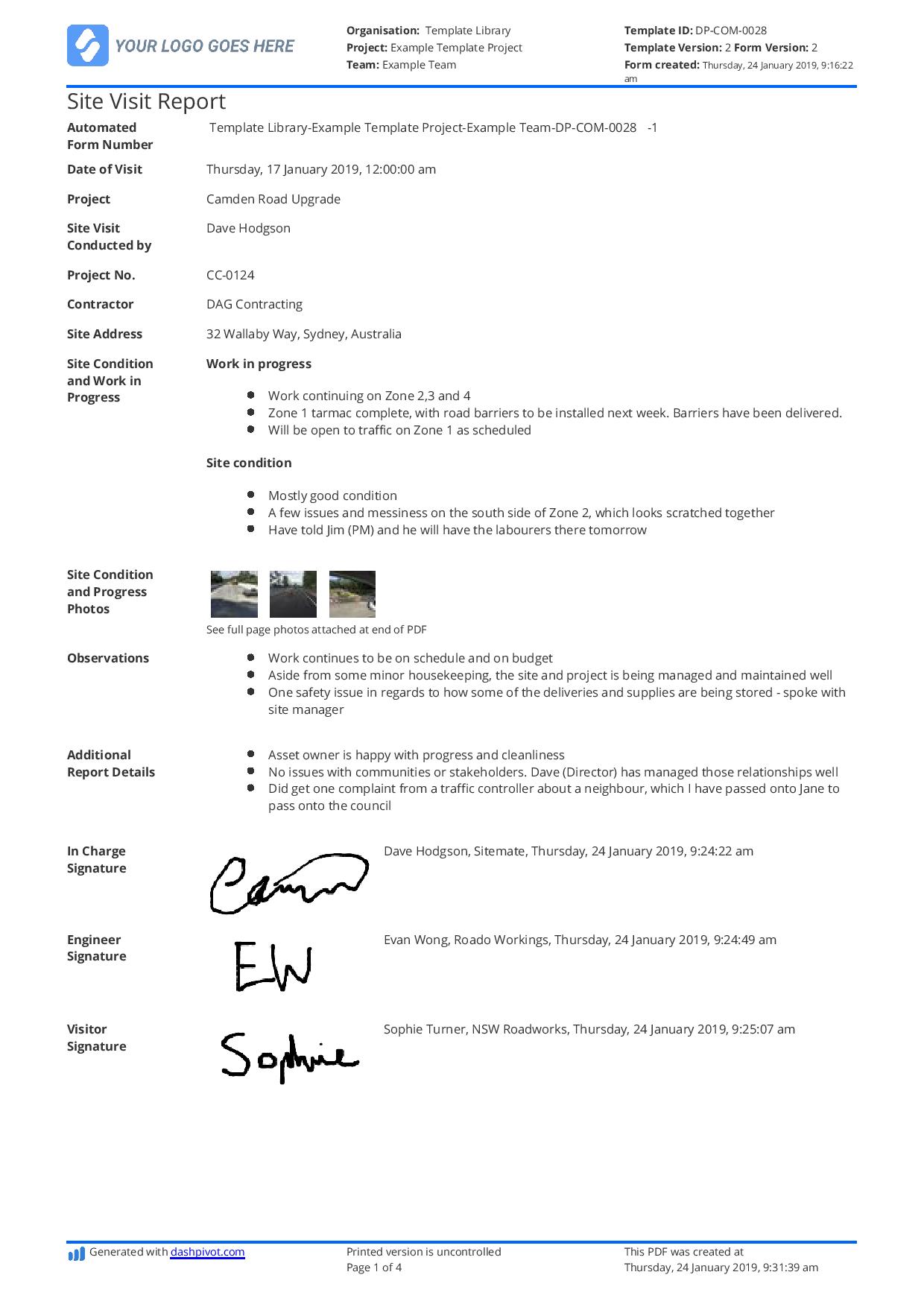
Use a free Site Visit Report template based on this Site Visit Report example
Digitise this site visit report example.
Make it easy for your team to fill out site visit reports by using a standardised site visit report template .
The free digital site visit report comes pre-built with all the fields, section and information from the site visit report example above for your team to carry out detailed reports.
Customise the report with any extra information you need captured from your site visit reports with the drag and drop form builder.
Distribute your digital site visit report for your team on mobile or tablet so they can fill it out on site while the information is still fresh and at hand.
Create digital workflows for your site visit reports
Make it easy for your team to request, record and sign off on site visit reports by utilising a dedicated a site visit report app .
Automated workflows move a site visit request from planning to recording to signoff a smooth and simple process.
Quickly and easily share completed site visit reports as perfectly formatted PDF or CSV so your team is always across what's been recorded.
Take photos of site progress on site via your mobile or tablet, attach directly to your site visit reports with automatic timestamps, geotagging, photo markup and more.

Site diary template
Complete and organise your daily diaries more efficiently.

Meeting Minutes template
Capture, record and organise those meeting minutes.

Progress Claim template
Streamline and automate the progress claim process to get paid faster and look more professional.
Sitemate builds best in class tools for built world companies.
About Nick Chernih
Nick is the Senior Marketing Manager at Sitemate. He wants more people in the Built World to see the potential of doing things a different way - just because things are done one way doesn't mean it's the best way for you.
Leave a Comment Cancel Reply
Save my name, email, and website in this browser for the next time I comment.

IMAGES
VIDEO
COMMENTS
From gaining professional knowledge to developing important life skills, here are eight reasons why site visits are the best learning experience: Image Sources: ©Lowa Public Radio. 1. Site visits allow for an authentic and accurate experience of the space. While we may think we know a space or building inside out from all the overtime put into ...
However, there are four good reasons for onsite leadership visits: Build Awareness. There is no substitute for being present and just listening. The cultural feel, situational contexts and office ...
A site visit report serves as a crucial tool in the realm of project management, bridging the gap between on-ground realities and managerial oversight. Its primary purpose is to document firsthand observations, activities, and conditions of a specific site at a given time, offering a snapshot of the project's progress, challenges, and ...
A site visit analysis is a comprehensive report that summarizes the findings of a physical inspection of a potential development site. It includes information on the site's physical characteristics, location, surrounding area, demographic information, environmental impact, zoning regulations, traffic flow, and recommendations for development. ...
Build intrapersonal and communication skills. A site visit will allow you to work in a team, learn to communicate with people, and develop your leadership skills. These are some of the most important skills needed for any job and you should get them early on in your career. A site visit provides an excellent learning experience, where you can ...
Here's a breakdown of what should typically be included in a site visit report report: Project Reference: The construction project name and reference ID. Location: The exact address or co-ordinates of the construction site. Date of Site Visit: The specific date (s) when the visit was recorded. Prepared By: The name of the individual or team ...
Why are site visits beneficial for team morale and engagement? Site visits can strengthen team bonds by bringing members together in a shared environment, which can enhance collaboration and foster a sense of unity and purpose. They also provide a break from the usual routine, which can be refreshing and motivating.
Go near, or go far. School site visits may be as close to you as your own district. A high school team can glean many insights by visiting one of their sending middle schools. Many school systems build intra-district visits into their annual routines. Alternatively, school site visits may be across your state or elsewhere in the country.
The purpose of an Architect's site visit is to oversee the construction process, ensuring that the project stays true to the design intent and adheres to quality standards. By doing regular site visits, Architects can monitor progress, identify and address any issues that arise, and maintain clear communication with contractors, engineers ...
Construction site visits are crucial for ensuring safety, compliance, and quality control on a project. These visits allow for inspections, assessments, and evaluations to be conducted, which can help identify and resolve any issues that may arise. By having a clear understanding of the project's progress, stakeholders can make informed decisions that will keep the project on track and within ...
The purpose of Site Visits is to allow offerors to obtain a better understanding of site conditions and the work required, as well as gather quality information about the solicitation and familiarize yourself with the procuring agency. Site Visit information is stated in solicitation documents and can be either mandatory or optional, they are ...
A Site Visit involves preparation and follow-up in the classroom, including research and reflection by students. Tours generally last between an hour-and-a-half to two hours. Purpose. Site visits provide an opportunity for students to learn about an industry, potential career opportunities, and jobs. The activities are designed to:
There are many benefits to architecture site visits, which help architects do the following: 1. Understanding the lay of the land. 2. Meeting the owner or developer. 3. Getting a sense of the project's scale. 4. Assessing the construction site's suitability.
For external evaluators, site visits (e.g. visiting schools) provide an opportunity to experience the activity, program, or product first-hand while also offering a chance to connect in-person with participants from a study. ... If appropriate, send participants a direct email one week prior to the visit restating the purpose of the observation ...
Site visits are invaluable for gathering details that will strengthen your quality responses, especially those that focus on Health & Safety, Contract Implementation and Risk Assessment & Mitigation. You can clarify any doubts that you may have about the information provided in the tender documents. This will again help you in your journey ...
Benefit #2: Discover new opportunities. Not only do site visits prevent logistical problems, they also open up new opportunities. When planning your meeting, you can (and should) do plenty of remote research. You'll most likely look up activities online, call the hotel concierge for recommendations, check Yelp and more.
the purpose enables the site visit team to collect, review, and synthesize the most relevant information prior to the site visit, and helps give the team focus when at the activity implementation site. A single site visit may address a number of purposes; however, not every site visit will be designed to monitor or review all aspects of ...
Michael Quinn Patton summarizes the essential elements of an evaluation site visit: Competence- Ensure that site‐visit team members have skills and experience in qualitative observation and interviewing. Availability and subject matter expertise does not suffice. Knowledge- For an evaluative site visit, ensure at least one team member ...
Smarter Site Visits. By Samantha Alarie-Leca. May 6, 2015, Indianapolis, IN. A former colleague and friend at a small education nonprofit recently called to pick my brain about the role of site visits from a foundation perspective. She was in the midst of planning a visit with a local program officer. A $10,000 grant was on the line, and she ...
Here's what's covered in the site visit report example: Header Information: Report Title: Clearly indicating it's a "Site Visit Report." Project Name/Title: Name of the project or site. Location: Address or description of the site visited. Date of Visit: The exact date the visit took place. Prepared By: Name of the person or team who prepared ...